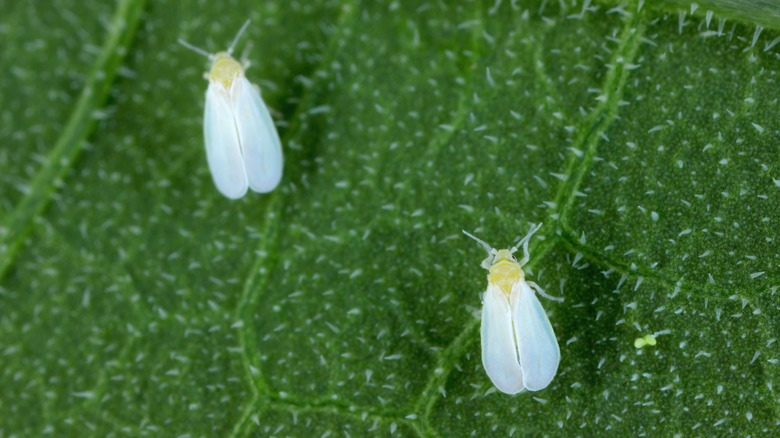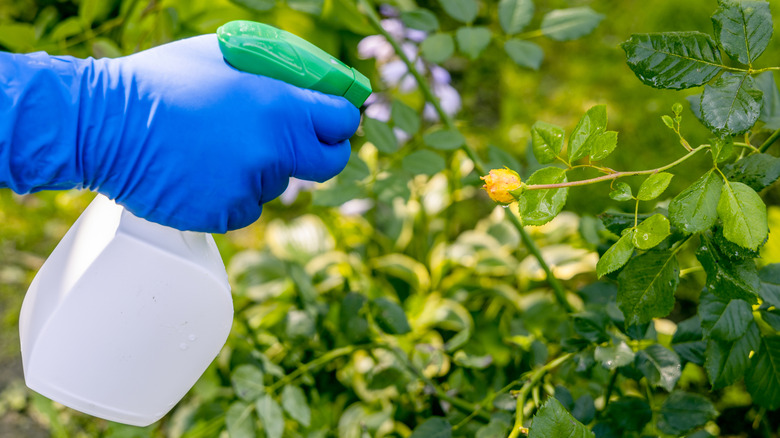The Early Signs Of Whitefly Damage On Heliotropes (And How To Stop It Fast)
Drooping leaves and the presence of a sticky substance with black, sooty mold are some of the most common signs of an infestation on your heliotropes (Heliotropium). Look a bit closer and you'll notice tiny winged bugs known as whiteflies. These minuscule insects might look harmless, but they pose big problems for your plants.
Greenhouse whiteflies (Trialeurodes vaporariorum), commonly called whiteflies, suck the nutrients from the leaves of plants. They're super fond of heliotropes, hardy perennials with clusters of blue, white, or purple flowers. When whiteflies feed on your heliotropes, they excrete a sap-like residue known as honeydew. This honeydew can go on to develop a sooty, black mold.
Left untreated, whiteflies can kill your heliotropes. But if you're vigilant about observing your plants, you'll be able to spot the symptoms quickly and get to work on a solution, whether it involves insecticidal soaps, neem oil, or more serious pesticides.
Treating your heliotropes to eradicate whiteflies
Like many garden pests, whiteflies have a short life cycle, which means just as you're killing off the adult offspring, there are new eggs hatching and growing to maturity in their place. As such, eradicating these bugs will likely take several rounds of treatment and a keen eye. Luckily, there are several methods for doing so ranging from manual removal to natural home remedies and powerful chemicals.
Chief among these treatments are insecticidal soaps, a combination of distilled water and Castile soap which kills pesky bugs by breaking down their exoskeletons. You can purchase these soaps ready-made at nurseries and home improvement stores, or you can make your own. Using this natural soap as an insecticide is just one of the genius reasons you should be using a bottle with your plants.
Another common treatment that's safe on plants but harsh on pests is neem oil. Both neem oil and insecticidal soaps work by making direct contact with whitefiles, which means you'll have to coat your plant — especially the undersides of the leaves — to ensure they're reaching their target. If your heliotrope's leaves have begun turning yellow, you can also remove these leaves by hand to eradicate some of the whiteflies. In some cases, spraying your plants with water can remove adults and eggs, helping to combat an outbreak.
Finally, you can use pesticides such as imidacloprid, which is used to treat the surrounding soil. But like many pesticides, imidacloprid can harm honeybees and other pollinators, so it's not typically recommended as the first line of defense. It's also not safe to use on vegetable plants.
Preventing whitefly outbreaks on heliotropes in the future
Heliotropes bring bright blooms to your garden and offer a pleasant aroma of what many describe as similar to vanilla, almond, or even cherry pie. They're also deer-resistant and a big hit with pollinators such as butterflies, bees, and hummingbirds. Keeping them happy and healthy, therefore, involves a pest regimen.
To prevent future outbreaks of whiteflies and other common pests such as spider mites, you can try introducing other plants that whiteflies dislike, such as marigolds. Reflective mulch also discourages whiteflies from landing on your plants, and is especially useful in vegetable gardens. In some cases, sticky traps are effective in catching and killing adult whiteflies.
Keep in mind that, while heliotropes can do well indoors where they're one of the houseplants that will make your home smell amazing, whiteflies can also flourish in your home. Outdoors, a whitefly's natural predators, including lady bugs and hummingbirds, are more likely to nip an infestation in the bud — no pun intended. Introducing natural predators is one of the best ways to get rid of whiteflies.


